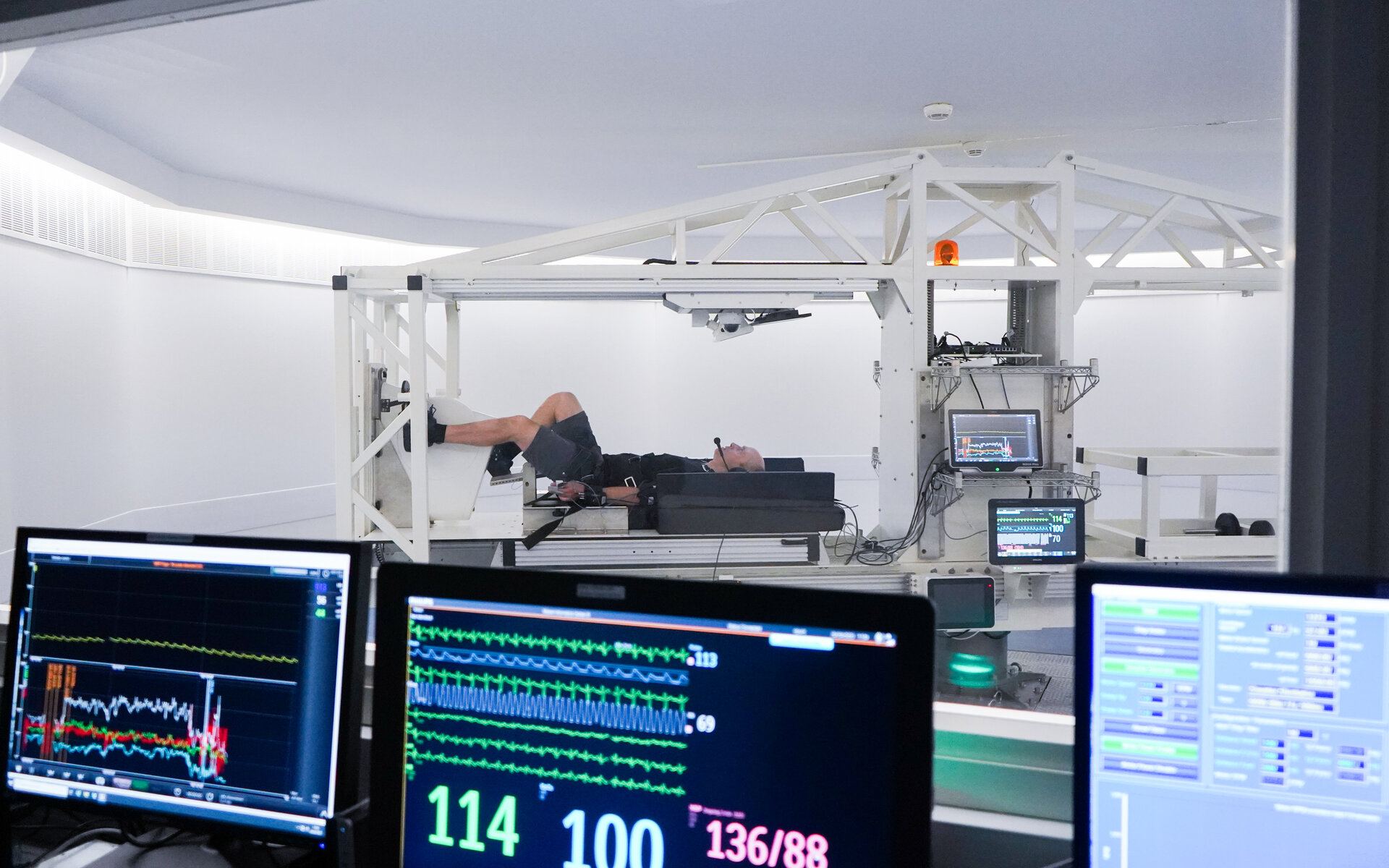They’re affectionately known as “pillownauts,” volunteers who commit to spending weeks in bed to advance research into astronaut health. While bedridden, the pillownauts will lie with their heads tilted at 6° below the horizontal with their feet up to increase blood flow to their heads. They also perform work-related tasks, are subject to regular medical exams, and take their meals, showers, and bathroom breaks, all while remaining in bed. The purpose of this research is to simulate the effects of weightlessness on the human body, including muscle atrophy, bone density loss, and cognitive effects.
The European Space Agency (ESA) recently kicked off another round of pillownaut research, the Bed Rest with Artificial gravity and Cycling Exercise (BRACE) study, at the Institute for Space Medicine and Physiology (MEDES) in Toulouse, France. For this study, twelve volunteers will remain inclined (with their heads below their feet) for sixty days and exercise using cycles adapted to their beds and centrifuges that simulate gravity. Beyond measuring the effects of microgravity on astronaut health, this study also aims to measure the effectiveness of countermeasures used to address them.
The effects of microgravity on human physiology are well-documented and include muscle atrophy, bone density loss, vision problems, and effects on the cardiovascular and central nervous systems. Aboard the International Space Station (ISS), astronauts follow a strict exercise regimen involving cardiovascular exercise and resistance training to mitigate these effects. Despite all these efforts, astronauts spending extended periods in microgravity will still feel the effects, and reacclimating to Earth gravity can be quite the ordeal (as demonstrated by NASA’s Twin Study).

Hence why NASA, the ESA, and other space agencies are looking for additional measures for use on long-range, long-duration missions to space. Simulated gravity, in the form of centrifuges and rotating toruses that can be adapted to spacecraft and space stations, is considered particularly promising. When astronauts are subjected to the centripetal force these generate, blood is driven toward their feet, and their musculoskeletal system is subjected to stress that mimics the familiar pull of gravity. The intensity of the centrifugal or rotational force can also be adapted to provide different levels of simulated gravity.
The BRACE study is supported by the French Space Agency (CNES). It builds on a previous artificial gravity study that ESA conducted with NASA and the German Space Agency (DLR) in 2019 at the German Aerospace Center’s :envihab facility in Cologne. This time, the study consisted of twelve volunteers divided into three groups. The first group of volunteers cycled in bed to simulate the regular exercise astronauts perform on the ISS while the second group performed the same exercises in a centrifuge that simulated up to two times Earth-normal gravity (2 g).
Volunteers can adjust this according to their tolerance of hypergravity. The results will then be compared to a third control group that spends the full sixty days in bed with no exercise or centrifuge rides. “We encourage volunteers to reach their maximum effort on the bike, and then compare the impact with those who are not biking at all,” explained Rebecca Billette, head of clinical research at MEDES, in an ESA press release. “We will compare the impact of a daily exercise routine on a variety of physiological factors.”

Artificial gravity is considered particularly promising because it acts on the entire human body – muscles, bones, organs, and connective tissue – all at once. Said Angelique Van Ombergen, the lead for life sciences at the ESA’s Human and Robotic Exploration section:
“We hope to understand the added value of artificial gravity to the fitness routine astronauts follow on the International Space Station. The crew exercise[s] two hours per day in orbit. It could become an effective solution for a healthier body during long-duration space missions, if the technological challenges can be overcome.”
In addition to addressing astronaut health, this research has extensive applications closer to home. The physiological problems experienced in space mirror those experienced by elderly and bedridden patients here on Earth. There is also the possibility that this research could lead to new treatments for patients who have osteoporosis, muscular dystrophy, and other degenerative diseases that lead to the progressive loss of strength, mobility, and organ function.
ESA has regularly organized bedrest studies of varying lengths since 2001, but this was the first time cycling was incorporated. The next study will consist of 12 volunteers and an ESA researcher team spending sixty days at the Jožef Stefan Institute in Slovenia. This test will study the effects of artificial gravity combined with vibration exercises, where volunteers will lie on a bed with a vibrating platform – which forces the muscles to contract and relax dozens of times per second.

Similar studies have been conducted by the NASA Johnson Space Center (JSC) and the University of Texas Medical Branch (UTMB), where a Short-Radius Centrifuge contributed by the JSC was used to simulate gravity on pillownauts. Efforts to realize simulated gravity in space include the Non-Atmospheric Universal Transport Intended for Lengthy United States Exploration (Nautilus-X) study conducted by the JSC in 2011. This concept envisions a rotating torus that could be mounted to a spacecraft or integrated into the ISS or Lunar Gateway.
Earlier this month, the multinational aerospace company Airbus unveiled its proposal for the Airbus LOOP, a Multi-Purpose Orbital Module (MPOP) that contains a habitation deck, a science deck, and a centrifuge with exercise bikes that allows two astronauts to work out in simulated gravity. This concept could be integrated into ISS or Lunar Gateway, into the proposed Deep Space Transport (DST), or combined with others to create a fully-fledged space station. These and other concepts could be vital in future missions that take astronauts beyond the Earth-Moon system in the coming decade.
Further Reading: ESA

